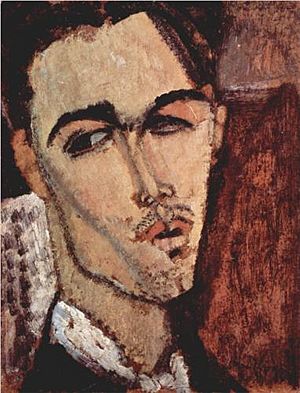Celso Lagar facts for kids
Quick facts for kids
Celso Lagar
|
|
|---|---|
 |
|
| Born |
Celso Lagar Arroyo
February 4, 1891 |
| Died | September 6, 1966 (aged 75) |
| Nationality | Spanish |
| Known for | Painting, Sculpture |
| Movement | First Generation School of Paris |
| Spouse(s) | Hortense Begué |
Celso Lagar Arroyo was a Spanish painter. In the late nineteenth century, he was one of the first generation Spanish expressionist painters from the School of Paris, where he lived most of his life. He was influenced greatly by Cubism or Fauvism.
Biography
Celso Lagar Arroyo was born in a small cathedral city Ciudad Rodrigo. In his early days, he went to Madrid to be part of the workshop of one of the best sculptors of the moment, Miguel Blay. During 1910 and 1911 he visited Barcelona. He later studied sculpture in Paris in 1911 on the advice of Blay. There he met Joseph Bernard, his friend Amedeo Modigliani and his future wife, the French sculptor, Hortense Begué. It would be precisely at that moment when he gradually abandoned sculpture and have chosen to select in favor of painting.
The outbreak of the First World War had a deep impact, in the life and work of Celso Lagar, the beginning of a new stage. He remained in Barcelona during the war, where he achieved a certain level of recognition, which allowed him to return to Paris. In 1919 he settled permanently in France. His works were exhibited in some of the notable Parisian galleries. After the period of avant-garde influences of Cubism, Fauvism, Vibrationism, Orphism, Divisionism, Ultraist, Celso Lagar has chosen his own distinctive path which is said to be having influence of Goya and Picasian. His works in this segment received considerable Critical and public recognition.
With the commencement of the Second World War and the end of the golden age both Lagar and his wife Hortense were forced to take status of refuge in the French Pyrenees amid very difficult living conditions. During this time, Lagar and his wife suffered from severe financial hardships. Hortense was admitted to the Broca hospital and in 1955 she died. Lagar falls into a deep depression after her death and was admitted to the Sainte Anne asylum. After his admission to the asylum, his artistic creativity succumbed. During this time, by court order, two auctions of the works which had been remaining in his workshop were held to pay for his stay in the asylum. In October 1964 he returned to Seville, Spain to leave with his sister until his death on September 6, 1966.
Works
His paintings are found in numerous museums throughout Europe, such as: La Rochelle, Goya Museum in Castres, Honfleur in France, Petit-Palais in Geneva, Museo Nacional Centro de Arte Reina Sofía, the Lis House in Salamanca, Carmen Thyssen Museum in Málaga and even in the notable collections such as Crane Kalman in London or Zborowski in Paris.
Some of his renowned works include:
- La vida en el campo (Life in the Country)
- El Retrato de Xavier Montsalvatge (The Portrait of Xavier Montsalvatge)
- Ensayo de luz por el planismo o Retrato de nena (Essay of Light through Planism and Portrait of a Girl)
- Arlequins (Harlequins)
- Jeune acrobate (Young acrobat)
- Clowns et haltérophiles (Clowns and weightlifters)
- Les bohémiens (Gypsies)
See also
 In Spanish: Celso Lagar para niños
In Spanish: Celso Lagar para niños

